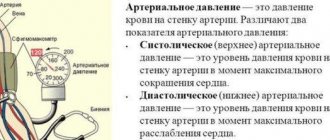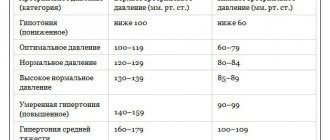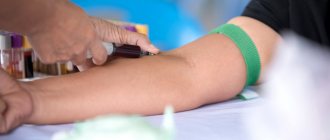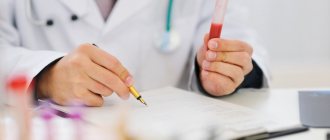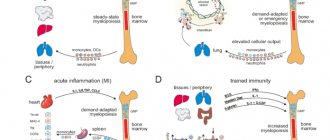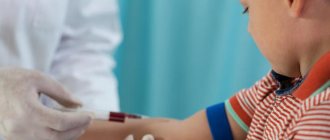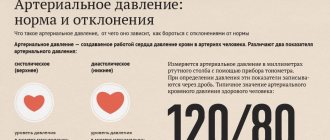The only way to know if you have high or low blood pressure is to measure your blood pressure. Understanding your results is key to controlling your blood pressure.
- Systolic blood pressure (First or top number) is the maximum pressure in the arteries when the heart contracts and pushes blood into the arteries.
- Diastolic blood pressure (Second or lower number) - shows the pressure in the arteries at the moment the heart muscle relaxes, it reflects the resistance of peripheral vessels.
Which number is more important?
Typically, more attention is paid to systolic blood pressure (the first number) as the main risk factor for cardiovascular disease for people over 50 years of age. For most people, systolic blood pressure rises steadily with age due to the loss of elasticity of the large arteries, an increase in heart rate, and the development of vascular disease.
However, an elevated systolic or elevated diastolic blood pressure value can be used to diagnose high blood pressure. The risk of death from coronary heart disease and stroke doubles with a 20 mmHg increase in systolic blood pressure. Art. or diastolic by 10 mm Hg. Art. among people aged 40 to 89 years.
Rules for measuring blood pressure
To get a reliable picture of a person’s health, it is important to measure blood pressure correctly; it’s not difficult:
- for an hour (at least 40 minutes) do not smoke, do not eat anything spicy, fatty, salty, do not drink strong drinks, coffee, tea;
- do not engage in physical labor;
- the position for measurement should be comfortable, in a sitting position, the hand for tonometry should be on a hard surface;
- two measurements are carried out, with an interval of several minutes;
- the cuff is placed above the elbow to make it comfortable when using a stethoscope.
Blood pressure ranges
In our country, we adhere to the standards of the European Society for the Study of Hypertension, and there are also recommendations from the Ministry of Health of the Russian Federation dated 2021, which established the following ranges of numbers:
- Normal - systolic blood pressure less than 120-129 mmHg, diastolic blood pressure less than 80-85 mmHg.
- Highly normal - systolic blood pressure 130-139 mmHg, diastolic blood pressure 85-89 mmHg.
- 1st degree – 140-159/90-99 mmHg.
- 2nd degree – 160-179/100-109 mmHg.
- 3rd degree – more than 180/110 mmHg.
Note: The diagnosis must be confirmed by a doctor. Hypertension is a disease or diagnosis, and hypertension is the very fact of increased blood pressure. Your doctor may also evaluate any unusually low blood pressure readings and associated symptoms.
Normal pressure
- Optimal blood pressure is SBP less than 120 mmHg. Art. and/or DBP less than 80 mm Hg. Art.
- Normal blood pressure is pressure in the SBP range of 120–129 mmHg. Art. and/or DBP 80–84 mm Hg. Art.
If your results fall into this category, stick to heart-healthy habits such as a balanced diet and regular exercise.
High blood pressure
High blood pressure is when the readings are consistently in the range of above 140 mmHg for systolic and for diastolic more than 90 mmHg. Art. Measures must be taken to control this condition.
Hypertension 1st degree
Stage 1 hypertension is when blood pressure constantly fluctuates systolic between 140–159 and/or diastolic above 90–99 mmHg. Art. During this stage of high blood pressure, doctors may recommend lifestyle changes and may consider taking blood pressure medications. What you do next depends on your risk and risk factors for atherosclerotic cardiovascular disease (ASCVD), such as heart attack or stroke.
Hypertension 2 and 3 degrees
Stage 2 hypertension is when blood pressure is constantly at the level of 160/100 mmHg. or higher. During these stages of high blood pressure, doctors may prescribe a combination of blood pressure medications and recommend immediate lifestyle changes.
Hypertensive crisis
This stage of high blood pressure requires medical attention. If your blood pressure reading suddenly exceeds 180/120 mmHg. Art., wait five minutes, and then check your blood pressure again. If your readings are still unusually high, contact your doctor immediately. You may be experiencing a hypertensive crisis.
If your blood pressure is above 180/120 mmHg. Art. and you are experiencing signs of possible organ damage, such as chest pain, shortness of breath, back pain, numbness/weakness, changes in vision or difficulty speaking, do not expect pressure relief. Call 103
Recommendations
Next, we consider the recommendations of specialists in the case of hypotension in elderly patients and pregnant women, as well as in cases of hypertension in children under 5 years of age.
For pregnant
If hypotension is physiological in nature and does not manifest itself as a violation of the woman’s condition, then the patient does not need treatment. It is imperative to monitor your blood pressure levels every time you visit an obstetrician-gynecologist or therapist. To normalize blood pressure, pregnant women will benefit from morning exercises, physical therapy exercises, water procedures (showers, douses, contrast foot baths), and massage. It is important to normalize sleep, the duration of which should be at least 9-10 hours a day.
For insomnia, the doctor may prescribe mild sedatives, but not barbiturate-based sleeping pills, as they are dangerous for the child. You should also diversify your diet. It should be rich in protein foods, fruits and vegetables. You can drink tea or coffee with milk only in the morning or afternoon; it is not recommended in the evening so as not to disturb your sleep. Women are also advised to take a closer look at herbal medicine recipes.
Important! The use of any remedies (both traditional medicinal and folk) during pregnancy should be discussed with an obstetrician-gynecologist.
For the elderly
The recommendations are as follows:
- Every day it is necessary to measure readings on both hands and record the data in a personal diary.
- You should get out of bed slowly so as not to provoke the development of orthostatic hypotension.
- It is important to have a hearty breakfast and drink a cup of weak coffee. Your daily diet must include foods rich in vitamins and minerals. If there are no contraindications, you need to drink enough liquid; you should not completely give up salt unless your doctor says otherwise.
- It is necessary to avoid prolonged stay in stuffy rooms, protect yourself from stress and significant physical exertion.
- Make time for walking and light exercise every day.
- If significant symptoms of hypotension appear, seek help from specialists.
Before using folk remedies to normalize blood pressure, it is necessary to exclude the presence of contraindications
For children
It is important to conduct a comprehensive examination to identify the cause of the pathology and select the necessary treatment, trying to return the numbers on the tonometer to normal without medications. What do we have to do? First of all, non-drug methods are used: changing the daily routine, adjusting the child’s menu, normalizing the ratio of rest and physical activity, etc.
Symptoms of low blood pressure
Most doctors consider chronic low blood pressure to be dangerous only if it causes noticeable signs and symptoms, such as:
- Dizziness
- Nausea
- Fainting
- Dehydration and unusual thirst
- Lack of concentration
- Blurred vision
- Cold, clammy, pale skin
- Rapid breathing
- Fatigue
- Depression
A single deviation from normal blood pressure readings is not a cause for concern unless you are experiencing any other symptoms.
Possible complications of pathology
If the pressure of 130 to 60 is unstable, then no pronounced pathological changes occur. However, with long-term and constant detection of values, it is necessary to consult a therapist or cardiologist. The most common complications of a high pulse difference are:
- Increased risk of developing emergency cardiac pathologies and cerebrovascular accidents.
- Intensive decrease in the tone and elasticity of the arteries.
- Disorders of kidney and liver function.
- Dysregulation of the nervous system.
Signs of emergency conditions
- Sharp headache. It's like being hit with a hammer. Baling, pressing, accompanied by other signs.
- Speech disorders. The tongue is not obeyed. You can test yourself at home by simply trying to say a simple phrase.
- Facial distortion. As a result of paralysis of facial muscles. Indicates damage to the cranial nerves.
- Inability to control half of the body.
- Severe, aching, dull pain behind the sternum with the development of shortness of breath and suffocation. Accompanying heart damage.
- Transient (passing) blindness or deafness.
These are symptoms of a heart attack or stroke. The intensity doesn't matter. Temporary ischemic attacks are possible. They precede a full-blown emergency.
If at least one sign is detected, you need to call an ambulance. Getting to the hospital on your own is dangerous.
Consequences and prognosis
Against the background of a constant decrease in blood pressure, the organs and tissues of the body do not receive the oxygen they need in full. In this case, the brain cells suffer the most. Hypoxia (oxygen starvation) causes the development of cognitive disorders: a person’s memory decreases, concentration and coordination are impaired. In old age, senile dementia develops.
Complications of hypotension may include:
- injuries sustained after fainting;
- visual impairment;
- heart, kidney failure;
- ischemic stroke;
- neurological pathologies;
- depressive states.
Predicting the outcome of the disease is quite difficult. It all depends on the effectiveness of blood pressure level correction.
Primary hypotension is difficult to treat. Blood pressure can be normalized in approximately 70% of all diagnosed cases. But this condition does not pose a particular threat to human life. A decrease in pressure to the level of 90/60 can occur for various reasons. And if the condition is accompanied by poor health, then the person needs to consult a doctor.
Causes
There are two types of hypotension. It is customary to highlight:
- Primary (physiological). It forms independently and does not cause serious changes in a person’s well-being.
- Secondary. Hypotension develops as a complication of an existing disease and is accompanied by severe symptoms.
Primary
Low blood pressure can be inherited. Women and girls with an asthenic body type are especially often hypotensive. The condition is not accompanied by severe symptoms. A natural decrease in blood pressure occurs during periods of hormonal changes:
- period of bearing a child;
- menstruation;
- menopause
Adolescent hypertension is an acceptable norm. The condition is caused by hormonal changes occurring in the body, lack of stability in the functioning of the cardiovascular system and too rapid growth of the child. Blood pressure stabilizes on its own after puberty and does not require any medical adjustment.
The development of primary hypotension can also be provoked by:
- overwork – nervous and physical;
- dependence on weather conditions;
- climate change;
- sedentary lifestyle.
In adults, primary hypotension occurs due to lack of physical activity. The result of physical inactivity is a decrease in the elasticity of the walls of blood vessels. But if an elderly person leads a fairly active lifestyle, then the primary form of hypotension does not threaten him.
No ads 1
Secondary
Secondary hypotension occurs as a complication of another serious disease. The reasons can be:
- pathologies of the thyroid gland;
- disruption of the pituitary gland and adrenal glands;
- anemic conditions;
- heart disease;
- brain injuries;
- diabetes;
- tuberculosis;
- infections;
- severe burns;
- allergy;
- intoxication of various origins.
The effectiveness of treatment for secondary hypotension depends on the results of therapy for the disease that provoked it.
Secondary hypotension sometimes occurs during long-term use of the following medications:
- diuretics;
- antispasmodics;
- ACE inhibitors;
- calcium antagonists.
[node:field_similarlink]
Treatment
Treatment and selection of drugs should be carried out by a qualified specialist. Therapy involves not only taking medications, but also adjusting your diet.
Drugs
Most often, the following groups of medications are prescribed:
- ACE inhibitors – prevent vascular stenosis;
- diuretics - necessary to remove excess fluid from the body and reduce the volume of circulating blood;
- beta blockers - improve the functioning of the heart muscle, protect the myocardium from the negative effects of hormones;
- sartans – relieve vascular spasms and quickly stabilize blood pressure.
Nutrition
To normalize blood pressure levels and return them to physiological norms, it is necessary to review a person’s diet. It is necessary to exclude spicy and fatty dishes/foods, coffee, strong black tea, alcohol of any strength, and sweets from the menu. Fresh berries, fruits, vegetables, cottage cheese, green tea, and cereals will benefit.
Exercise stress
A blood pressure of 130/80 is considered slightly elevated. To stabilize the indicator, doctors recommend swimming. This sport helps strengthen the muscle corset, improves blood circulation, and helps with weight loss.
Water aerobics classes are one of the options for physical activity that allows you to stabilize blood pressure levels.
Shows good results:
- water aerobics;
- long walks in the fresh air;
- regular morning exercises;
- Eastern dance;
- yoga;
- easy running;
- Pilates.
Important! You can use an exercise bike or treadmill, but don't do it too hard.
Folk remedies
To improve your well-being and stabilize blood pressure, you can use traditional medicine recipes.
- In mineral water without gases (250 ml), stir honey (1 tbsp.) and juice from ½ lemon. Drink in the morning before breakfast.
- Combine beet juice (400 ml), lemon juice (from 1 fruit), cranberry juice (1.5 cups), liquid honey (250 ml) and the same amount of vodka. Mix the ingredients and take 1 tbsp. l. means 60 minutes before meals three times a day.
- Mix rose hips (3 tbsp), currants (2 tbsp), chopped nettles (1 tbsp), red rowan (2 tbsp). Place the mix in a thermos and pour boiling water (1 l). Leave for 4 hours. Filter and take ½ cup warm 30 minutes after eating.
Since older people do not tolerate a decrease in blood pressure to the level of 130/80, it needs to be increased. Chinese lemongrass, ginseng, and eleutherococcus can be used as stimulants. While taking stimulant medications, it is necessary to monitor blood pressure readings.
